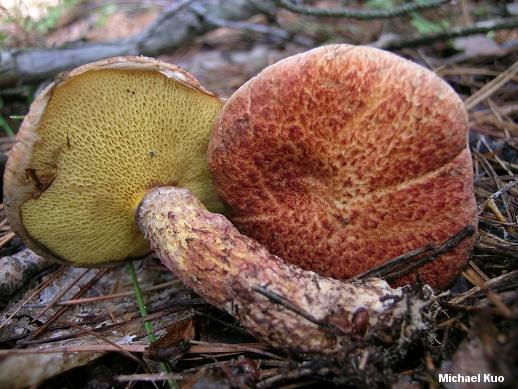Contents
Butter dish painted (I splurged)
- Division: Basidiomycota (Basidiomycetes)
- Subdivision: Agaricomycotina (Agaricomycetes)
- Class: Agaricomycetes (Agaricomycetes)
- Subclass: Agaricomycetidae (Agaricomycetes)
- Order: Boletales (Boletales)
- Family: Suillaceae
- Genus: Suillus (Oiler)
- Type: Suillus spraguei (Painted oiler)

Butter dish painted (I splurged) belongs to the genus Oilers.
External description of the fungus
The cap of a painted butter dish has a diameter of 3 to 15 (and in exceptional cases up to 18) cm. Along its edges, one can often see the remains of a private bedspread in the form of flakes. The shape of the cap can be wide conical, or cushion-shaped (in the middle in this case there is a noticeable tubercle). There is also a flat-cushion-shaped hat shape for the painted butter dish, in which the edges are wrapped at the top. The shade of the hat changes in different weather, becoming brighter and darker with high levels of humidity outside. As it matures and ages, the cap of the mushroom turns yellow, sometimes acquiring a yellow-brown hue. A change in color also occurs when the fungus is damaged by insects. At a young age, the color of the cap of a painted oiler can be red, brick red, burgundy brown, wine red. The surface of the cap is covered with small scales of a gray-brown or brown hue, through the layer of which the surface of the mushroom cap itself is visible.
The length of the stem is 4-12 cm, and the thickness is 1.5-2.5 cm. Sometimes it can thicken up to 5 cm at the base. In the annular zone of the fungus, there are many tubules descending along the stem and forming a mesh. The color of the stem is yellow, and at the base it is rich ocher. The entire surface of the leg is covered with red-brown scales, gradually drying out.
The spore tubes of the fungus are quite large, their width parameters are 2-3 mm. In their structure, they are elongated radially, descending on the leg in uneven lines. The color of the tubules can be saturated ocher, bright yellow, ocher-brown, turning brown immediately after pressing, pressing on the surface, or damaging the structural fibers of the fungus. They are very difficult to separate from the hat, because the tubules seem to have grown to it.
The pulp of the mushroom is characterized by yellow color, high density. On the cut, the flesh turns red, often acquires a red-brown hue. The taste and aroma of mushrooms of this species is mild, pleasant and mushroomy. The private bedspread is characterized by a pinkish-white or white color, it has a small thickness and fluff. In ripe mushrooms, in place of a private cover, a gray or white ring is formed, darkening and gradually drying out.
The fungal spore powder has a clayey, olive-brown or yellow-brown hue.
Habitat and fruiting period
The fruiting period of the Oiler painted (I splurged) begins in early summer (June), and ends in September. This type of mushroom prefers to settle on fertile soils, sometimes in the middle of mossy areas. Often they can be found as part of whole mushroom colonies. The commercial species of these mushrooms is distributed on the territory of the Far East in Our Country and Siberia. Forms mycorrhiza with cedar pine, also growing in Siberia. Rare, but still found in Germany and some other European countries. In the northeastern part of North America, this fungus is also widely distributed, forming mycorrhiza with weymouth pine in those areas.
Edibility
Butter dish painted (I splurged), undoubtedly belongs to the number of edible mushrooms, it can be fried, boiled, cooked mushroom soups. Suitable for consumption even without preliminary boiling or frying.









